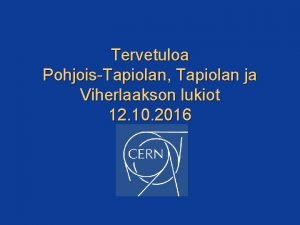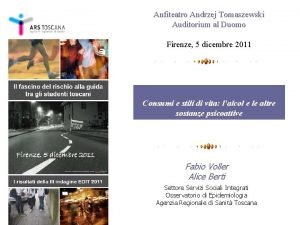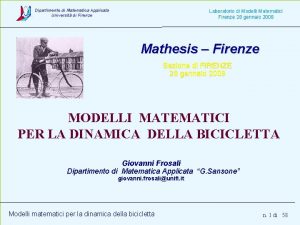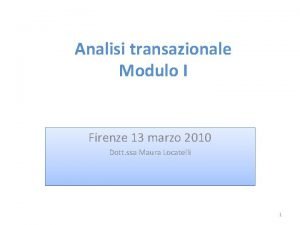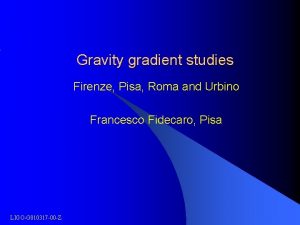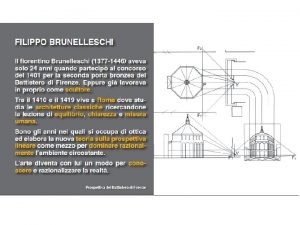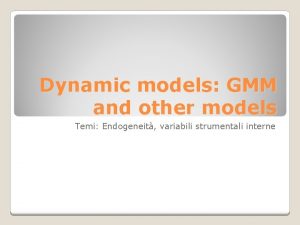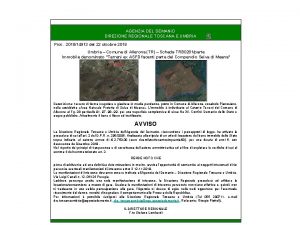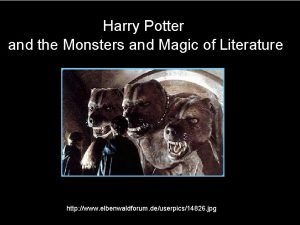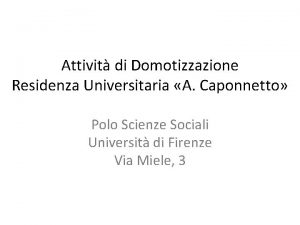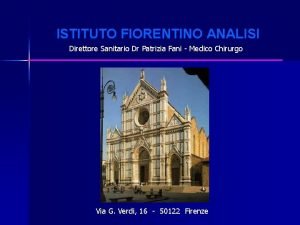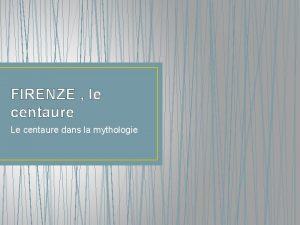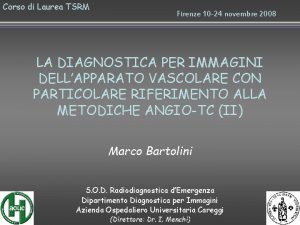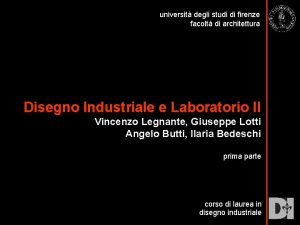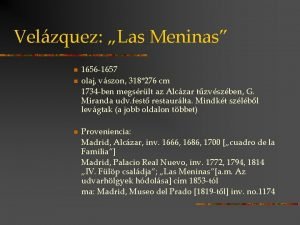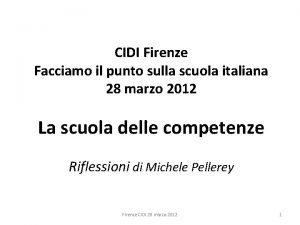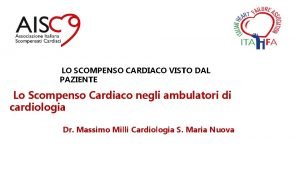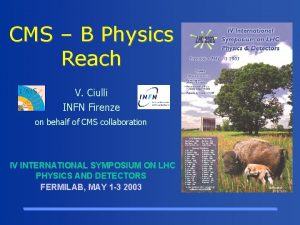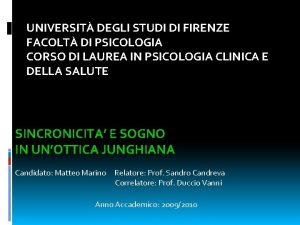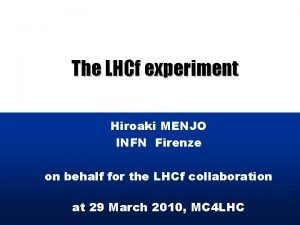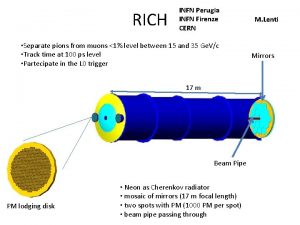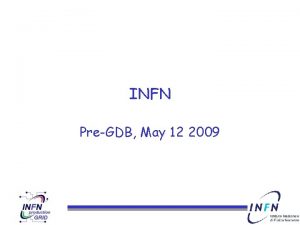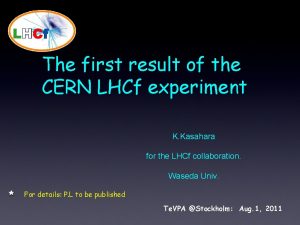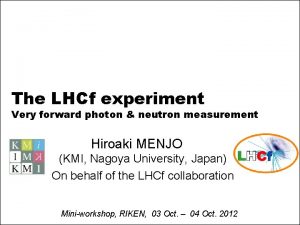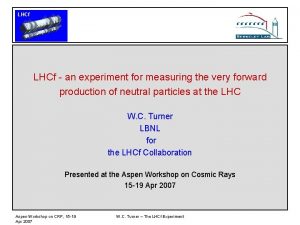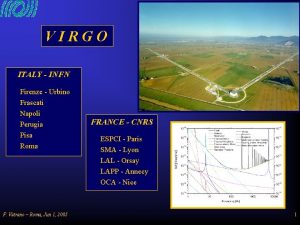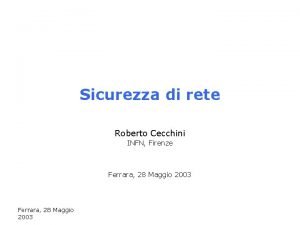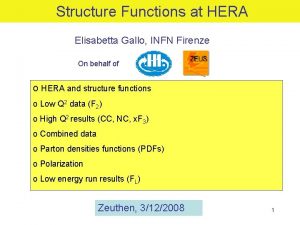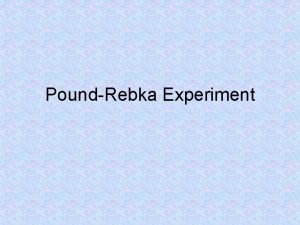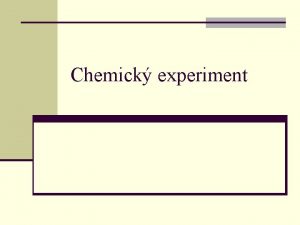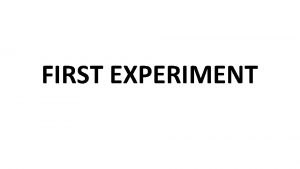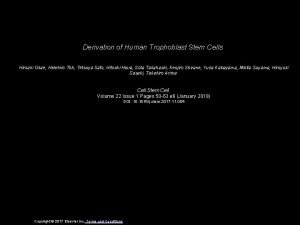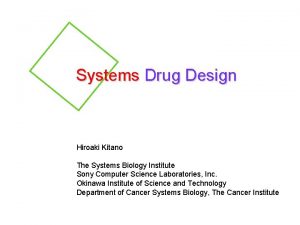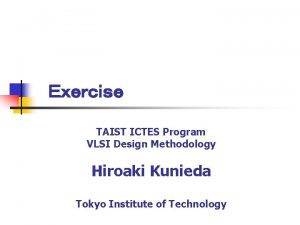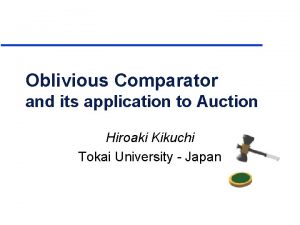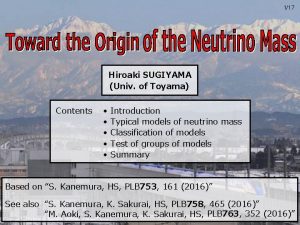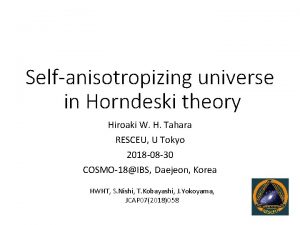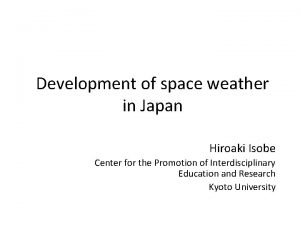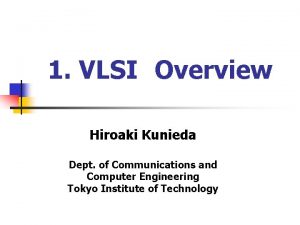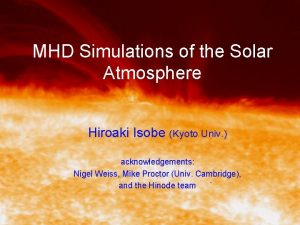The LHCf experiment Hiroaki MENJO INFN Firenze on




























- Slides: 28

The LHCf experiment Hiroaki MENJO INFN Firenze on behalf for the LHCf collaboration at 29 March 2010, MC 4 LHC

Outline LHCf = “LHC forward” What is the LHCf experiment ? - LHCf is one of forward experiments at LHC, with calorimeters covering h>8. 4. Why does LHCf look at the very forward region ? - To measure the most energetic secondaries which play an important role in air shower developments of cosmic rays. What can LHCf measure ? - Energy spectra and PT distribution of neutral particles, gamma-rays, neutrons and p 0. The data is useful to calibrate hadron interaction models.

- LHCf collaboration 6 countries 12 institutes 31 members CMS/TOTEM LHCf ALICE ATLAS LHCb

Location LHCf Detector(Arm#1) ATLAS 140 m Inside of TAN LHCf Detector (Arm#2) -Neutral particle absorber- Detectors at zero degree of collisions Detector TAN Neutral particles 96 mm charged particles IP 140 m The detector has been installed in 96 mm gap of the beam pipes.

The Main Calorimeters Sampling Calorimeter • W 44 r. l , 1. 7λI • Scintilator x 16 Layers Position Detector • Scifi x 4 (Arm#1) • Silicon strip detector x 4 (Arm#2) Two independent calorimeters allow to reconstruct π0 Schematic view of the calorimeters in Arm#2 Expected Performance: Energy resolution (> 100 Ge. V) < 5% for photons 30% for neutrons Position resolution 40 mm < 200μm (Arm#1) 40μm (Arm#2) 20 mm 32 mm 25 mm Schematic view of the calorimeters in Arm#1

Arm#1 Arm#2 620 mm 280 mm 92 mm 90 mm 280 mm

Beam test at SPS Detector Energy Resolution for electrons with 20 mm cal. p, e-, m u - Electrons 50 Ge. V/c – 200 Ge. V/c - Muons 150 Ge. V/c - Protons 150 Ge. V/c, 350 Ge. V/c Position Resolution (Silicon) Position Resolution (Scifi) σ=172μm for 200 Ge. V electrons σ=40μm for 200 Ge. V electrons

p 0 reconstruction at the beam test Arm#1 Detector Fixed Target Acrylic or Carbon 10 m p 0 mass was reconstructed from Calibration over SPS energy Response of all PMTs for large amount of light over SPS energy upto 70, 000 MIPs eq. (7 Te. V elemag shower) has been calibrated by a fast N 2 laser. ADC counts(0. 025 p. C) gamma-ray pair measured by the both two calorimeters 70, 000 MIPs eq. Light Intensity(MIPs)

Sub detectors -Front Counter. Thin scintillators with 8 x 8 cm 2 acceptance, which have been installed in front of each main detector. Schematic view of Front counter • To monitor beam condition. • For background rejection of beam-residual gas collisions by coincidence analysis http: //op-webtools. web. cern. ch/op-webtools/vistars. php? usr=LHCF

Movable detectors Transverse projection of. Transverse Arm#1 calorimeters projection atofzero-crossing at crossing angle of angle. 140 urad. Arm#1 calorimeters ηη 8. 4 8. 7 ss i x a s i i x x m a eeaam a m b a l e a b r b t l l u neunntereautra ∞ ∞ Shadow pipes Shadow ofbeam pipes Shadow ofofbeam pipes between TAN between IPand TAN between IPIPand TAN

Detectors in LHC IP 1, ATLAS Detectors in slots of TAN located 140 m far from IP 1

= Why the very forward region = The motivation comes from observations of Ultra High Energy Cosmic-Rays (UHECRs). XMAX ~1020 e. V Fe -Experiments- AGASA Hi. Res AUGER <Xmax> : one of indicators for TA cosmic-ray composition ton o r P <XMAX> [g/cm 2] AGN etc. E=1019 e. V Proton Photons Depth[g/cm 2] EPOS QGSJET 2 Iron 1018 e. V 1019 e. V Phys. Rev. Lett. , 2010, 104, 091101

= Why the very forward region = Uncertainty of hadron interaction models induces effective systematic error, especially for composition study of UHECRs. But now we have LHC to calibrate interaction models at 7+7 Te. V pp, equivalent to 1017 e. V in lab. !! Key parameters Total cross section ↔ TOTEM, ATLAS(ALFA) Multiplicity ↔ Central detectors Inelasticity/Secondary spectra ↔ Forward calorimeters LHCf, ZDCs

Rapidity distributions at 7+7 Te. V pp = Multiplicity = = Energy Flux = Calculated with DPMJET 3, dashed line: neutral particles In forward region (h>8. 4), Quite Low multiplicity, but Covering > 50% of total energy flux.

XF 0. 1 1. 0 η> 8. 4 Spectra of Secondary gamma-rays η> 8. 7 Ratio Detectable/All Most of all energetic neutral particle (XF>0. 1) are detectable by LHCf

= What LHCf measure ? = What LHCfcan measure Energy spectra and Transverse momentum distribution of Gamma-rays (E>100 Ge. V, DE/E<5%) Neutral Hadrons (E>a few 100 Ge. V, DE/E~30%) Neutral Pions (E>700 Ge. V, DE/E<3%) at psudo-rapidity range >8. 4 LHCf can measure only inclusive spectra !! LHCf trigger is completely independent on ATLAS trigger. However it is possible to identify coincidence events with ATLAS event by offline, and to analyze with center region (ATLAS) in future.

MC model discrimination at 14 Te. V g n at 7 Te. V + 7 Te. V pp 106 collisions ↔ 2 min. exposure @ 1029 cm-2 s-1 w/o resolution n

MC model discrimination at 14 Te. V Expected Measurement spectrum by Arm 1 0 p Reconstruction of p 0 = PT distribution = 107 collisions ↔ 20 min. exposure @ 1029 cm-2 s-1

MC model discrimination at 7 Te. V Energy spectra g at 3. 5 Te. V + 3. 5 Te. V pp with 5% energy resolution n with 30% energy resolution 1. 5 x 106 collisions ↔ 3 min. exposure @ 1029 cm-2 s-1 We will see 7 Te. V collisions tomorrow !!

MC model discrimination at 900 Ge. V Expected energy spectra with the 20 x 20 mm calorimeter at 107 collisions g w/o resolution at 450 Ge. V + 450 Ge. V pp DPMJET 3 QGSJET 2 QGSJET 1 SYBILL n w/o resolution We took data in 2009 Backgrounds due to interaction between secondaries and pipes

Preliminary results at 900 Ge. V In last year, LHCf took 6, 000 shower events at 900 Ge. V collisions. ↔ > 106 collisions at all IPs. Shadow of beam pipes Red: colliding bunch = collision + BG Blue: single bunch = BG only Presented at CERN 18 -Dec-2009

H ad MC with DPMJET 3 Data in 2009 un ron de re r s sp tu on dy se Preliminary results at 900 Ge. V pr eli m ina ry Checking detector response for hadrons carefully by beam test data with 150 Ge. V, 350 Ge. V protons. Presented at LHCC 17 -Feb-2009 Analysis is ongoing, and we will get some times more statistic soon !!

Operation Plan We will take data in LHC commissioning phases with low luminosity at every collision energy. 2009 Took data at 900 Ge. V collision. ~6, 000 shower events 2010 Take data at 900 Ge. V again. Operation at 3. 5+3. 5 Te. V till 2 pb-1. Then remove detectors and upgrade them. Install detectors again. Operation at 7+7 Te. V 2013 + we want to measure at intermediate energy ~1. 5+1. 5 Te. V, if LHC has. + we want to measure at light Ions+Ions collisions.

Summary The LHCf experiment is one of forward experiments at LHC, with calorimeters covering h>8. 4. LHCf looks at very forward region to measure the most energetic secondaries which play an important role in air shower developments of cosmic rays. LHCf can measure energy spectra and PT distribution of neutral particles, gamma-rays, neutrons and p 0. The data is useful to calibrate hadron interaction models.

Backup

Arm 1 g event

Arm 2 g event

Arm 2 neutron event
 Lhcf
Lhcf Auditorium al duomo firenze
Auditorium al duomo firenze Dipartimento di matematica firenze
Dipartimento di matematica firenze Analisi transazionale firenze
Analisi transazionale firenze Convegno ecclesiale di firenze documento finale
Convegno ecclesiale di firenze documento finale Libera firenze
Libera firenze Gravity sensitivity firenze
Gravity sensitivity firenze Firenze 1265
Firenze 1265 Linguaggio brunelleschiano
Linguaggio brunelleschiano Endogeneit
Endogeneit Agenzia del demanio firenze
Agenzia del demanio firenze Rab harry poter
Rab harry poter Residenza universitaria caponnetto firenze
Residenza universitaria caponnetto firenze Istituto di analisi fiorentino
Istituto di analisi fiorentino Tumulto dei ciompi a firenze
Tumulto dei ciompi a firenze Firenze centaure
Firenze centaure Tc embolia polmonare roi
Tc embolia polmonare roi Fondazione commercialisti firenze
Fondazione commercialisti firenze Facoltà di architettura firenze
Facoltà di architettura firenze Las meninas
Las meninas San giorgio donatello
San giorgio donatello Centro impiego scandicci
Centro impiego scandicci Firenze toomkirik
Firenze toomkirik Dante guelfo bianco nero
Dante guelfo bianco nero Cidi firenze
Cidi firenze Dott milli cardiologo
Dott milli cardiologo Cms firenze
Cms firenze Cinque vie firenze
Cinque vie firenze Università degli studi di firenze psicologia
Università degli studi di firenze psicologia
